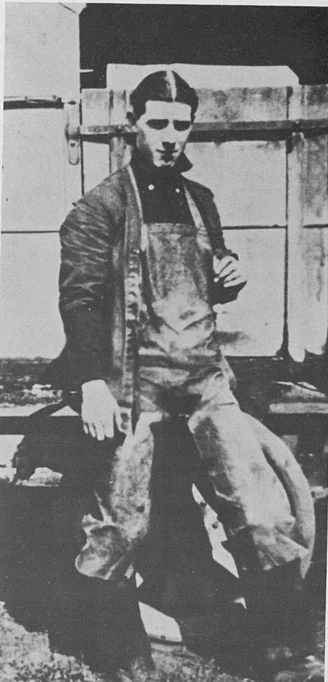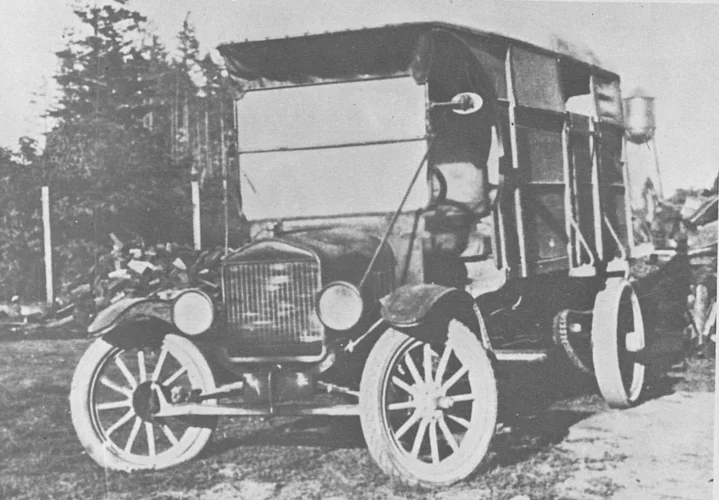The Model-T ice wagon made the rounds of the town.
Children who grew up in Eureka in the 1920s were about as likely to experience the joys of sucking on a piece of ice as a child in the Mojave Desert. But there were a select few of us living on Brett Street (now 14th Street), who, for several years, enjoyed this rare treat every summer. How could such an unlikely pleasure happen in Eureka — and anyway, who needed ice in the center of the cool fog belt?
Well, it happened this way! Amos Christie, while a college student at the University of Washington from 1920 to 1924, spent his summers delivering ice for the Eureka Ice Company in a Model T pickup to various customers such as the Union Labor Hospital, the Humboldt County Hospital, Rosaia’s Fruit and Vegetable Market, Lazio’s fish wharf, the saloons on Second Street, and several “lady-of-the-night” houses. After all, a girl had to have a little ice for her customers’ drinks in the seclusion of her workshop.

When Amos Christie wasn’t going to school during vacation he became Eureka’s favorite ice man. Here he is with his leather apron and upturned collar—a fad of the day in (1922).
At the Union Labor Hospital the ice was used to make ice cream for the patients on Sundays, and Amos was the one who hand cranked the freezer. He fell into this chore naturally since he lived there, sharing a single room (No. 27) with his mother during the summer vacations. His mother, Mrs. Edna Christie, was the dietician for the hospital and always saw to it that the patients had a little to eat on Sundays.
Delivering ice often took him down Williams Street to Brett, where he was somewhat of a hero, partly because he was always good for a piece of ice, and partly because he was a college football player: he played for the University of Washington and on teams which went to the Rose Bowl twice.
About the same time, another football player. Red Grange, was gaining fame. He delivered ice in his home town in Illinois, so Amos was called “Eureka’s Red Grange,” although he was a tackle and Red Grange was a running back.
On Saturday evenings he occasionally went shopping downtown with his mother, and, of course, encountered a few of his lady-of-the-night customers who always recognized him and gave the friendly nod. His mother probably never understood the connection.
Amos Christie went on to become a physician, graduating from the University of California Medical School in 1929. After residency training in pediatrics at the University of California Hospital, postdoctoral fellowships took him to Johns Hopkins, Babies Hospital in New York City and the Harvard School of Public Health. Early in World War II he was Associate Director of the American Red Cross in Washington, D.C. In 1944 he became professor and chairman of the Department of Pediatrics at Vanderbilt University School of Medicine where he made his greatest contributions to the medical world. It was here that he and his colleagues unraveled some of the mysteries of Histoplasmosis, a fungus disease which looks like Tuberculosis by x-ray.
It was here that he trained many great pediatricians, many of whom went into practice and others remained in the academic world. At one time 16 chairmen of departments of pediatrics had been trained at Vanderbilt by Amos Christie and his staff. Several became Deans and one became a Nobel Prize laureate.
So,if your son wants to be an ice man, don’t knock it! One of Eureka’s most illustrious natives started off that way!
###
Dr. Robert Quinn, a native Eurekan and now head of Department of Preventive Medicine and Public Health, School of Medicine, Vanderbilt University, Nashville, Tenn., 37232.
###
The story above was originally printed in the September-October 1982 issue of The Humboldt Historian, a journal of the Humboldt County Historical Society, and is reprinted here with permission. The Humboldt County Historical Society is a nonprofit organization devoted to archiving, preserving and sharing Humboldt County’s rich history. You can become a member and receive a year’s worth of new issues of The Humboldt Historian at this link.

CLICK TO MANAGE